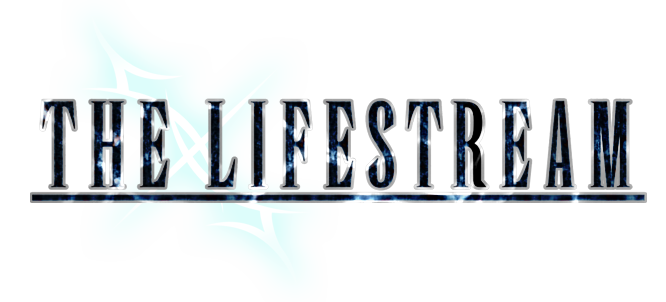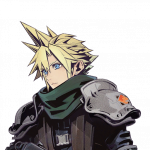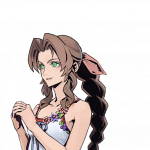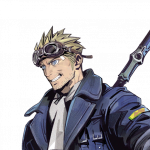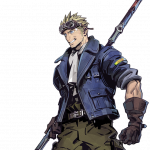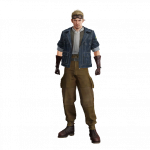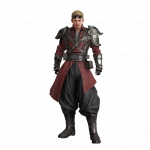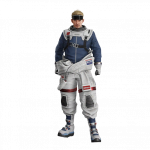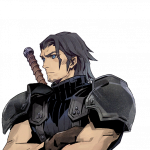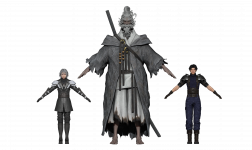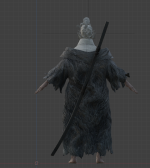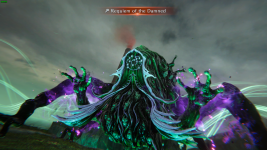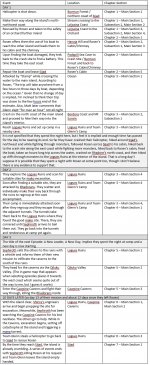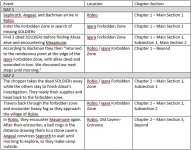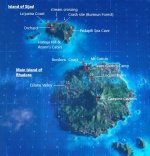This as a "berserker" design has its roots in Guts from
BERSERK who
loses his right eye & left arm during a traumatic event of the Eclipse where he sees his former companion turned into an inhuman godlike monster, and replaces his arm with
a prosthetic cannon (Cloud & Barret split this design between them with Corel & Nibelheim incidents as similar catalysts for their hatred). Cloud's facet of the Berserker overlaps with
Prince Ashitaka's infectious wound from the Demon of Hatred on his right arm in Princess Mononoke which causes his limb to act on its own out of anger and grant him superhuman combat abilities (a design which
was paralleled a lot in The Legend of Zelda: Tears of the Kingdom). These are largely the most iconic starting points for those themes in modern media, but there are a lot of other iterations of how those are used and how that concept evolves narratively that are important to touch on as
Ever Crisis & Masamune are connected to that same core, but with a LOT more history now – but Masamune is missing his right eye.
This is something that's been a part of
the character Berserker in Korea's Dungeon Fighter Online where it a sign of his infection with
Khazan Syndrome. A key part of the story of the upcoming
The First Berserker: Khazan in the DFO universe reveals that the possession is connected to
the Blade Phantom, the soul of the collective consciousness of vengeance, thus it parallels a lot of those same designs with
Nightmare from Soul Calibur. There's
Terra in Kingdom Hearts II who has his left arm completely armored – which can be activated to enclose and seal his entire body emphasizing that the struggles to control the darkness within his heart are at the center of his story. It's also why in
Sekiro: Shadows Die Twice the
Shinobi Prosthetic replaces Wolf's severed left arm, as the prosthetic's former owner the
Sculptor turns into the
Demon of Hatred with his missing left arm re-manifesting as a burning monstrous limb. Additionally, the
Shura ending of that game has Wolf taken over by that same insatiable bloodlust & violence burning out through his left prosthetic limb and consuming his entire body, turning him into "Shura"
This is drawing on wordplay between
Asura 阿修羅 (the Buddhist god of war) & Shura 修羅 (being a violent conflict / slaughter) – something we'll return to later on as it's got deeper links to other parts of Japanese history. The core is that it shows the darker possibility of the dynamic that comes from an Indra-Asura conflict like we see with a heroic protagonist rebelling against the powerful establishment. These dynamics were explicitly highlighted in
Naruto (Asura) against the quintessential Japanese hero archetypical hero Sasuke (Indra) in Naruto, and then adapted overtly from the Hindu/Buddhist roots in
Asura vs Deus/Chakravartin in Asura's Wrath, by
CyberConnect 2 – who were originally the team brought on to work on
Remake with SE. The dynamic of that reflecting that role Cloud has in juxtaposition to Sephiroth is a long one where one of the key inspirations is all about the possibility for the darker twist to that goes back to more direct adaptations in the form of
R.G. Veda by CLAMP, with the titular character Ashura pivoting to darkness & annihilation rather than heroism – resulting in needing to be sealed away again.
As such, there isn't a "good vs. evil" from the Indra-Asura dynamic, but rather a more delicate contextual balance on when Indra represents a power needed to bring stability to violence & disorder and when Indra represents a power of injustice & authoritarian oppression. Thus Asura's role as a force of necessary change to overcome the injustices of authoritarian oppression are ones where it's important to expand upon how it can easily mask something far FAR worse coming into power without anything capable of stopping it any more, and spreading destruction completely unchecked.
Elden Ring carries those same over themes from
Sekiro with
the demonic swordsman Okina coming from the Land of Reeds as a fictionalized Japan where he loses himself to everything other than just constant combat & slaughter the way that the blood-drunk hunters in
Bloodborne became murderers whose thirst for slaughter in the hunt cannot ever be sated.
Okina's Mask and
his katana, Rivers of Blood who technique is Corpse Piler emphasize that as existence whose sole purpose is endless killing, and both have a VERY similar visual design to Masamune in
Ever Crisis. This is further emphasized in
Elden Ring's theme with that obsession in fighting others as Bloody Fingers (PvP invasions) being linked to
Bloodflame for that insatiable burning from within that takes over the person who you once were who sees others as human, and replaces it with a monster. Another facet shows that a parallel emergence comes from roots in
mercy killings performed by War Surgeons, where
"a sense of mercy is a catalyst for bloodlust" where that urge rapidly stopped being a swift & efficient kindness for people suffering inescapable pain, and became obsessive and self-serving murder that defined them as killers. This is also what we see with Masamune in
Ever Crisis initially killing to stop others from stealing that coveted blade, before eventually succumbing to that same darkness himself.
This is why in media where the darkness is tied to a physical form, there's often an
Eye of Sauron motif used for things like
Nightmare in the form of Soul Edge in Soul Calibur, several
Keyblades, like The Gazing Eye in the Kingdom Hearts series, as well as the Blade Phantom in
The First Berserker: Khazan, as forms of that darkness manifested as a spirit where that prolonged contact erodes away the best parts of anyone in possession of that thing, and turns them into someone clinging to power out of fear. Thus, that vulnerability also often shuts itself off from the outside world and wraps them away completely in a suit of armor similar to
Guts' Berserker Armor in BERSERK. Thus, hiding or sealing away all the vulnerabilities & threats together. In
The First SOLDIER Episode II Chapter 1 where Masamune is in regular garb, we learn that he poured his heart & soul into that blade.
In Chapter 2 Masamune has his chest bare and the damage is openly visible as everyone is now within the seal that both protects the outside and traps it inside reveals what's happening within. Thus we get to see Demon Masamune (呪鬼マサムネ) with missing right eye & burning left arm.
This theme overlaps with the glowing or beast-like inhuman eyes associated with berserkers literally seeing red and turning feral, which Masamune exhibits before his attack "All-Encompassing Darkness" (闇刃虚滅衝) which explicitly inflicts the "Pain" status effect. This connects to the more Japanese-specific focus of passion being turned to destruction depicted as a fire coming from within a wound of the heart that grows to control & consume the body – like we see with the blade emerging from Demon Masamune fundamentally changing him into an unsympathetic murderer, and "Incandescent Spirit" (刀霊光芒・改) is specifically the blade's spirit hence it amplifying his attack power, while the creation of flames with "Smith Forging III" (焔造り) tempers his body like a blade against damage from being quenched by ice & water (his weaknesses that have to be exploited during the battle). Masamune is ethereal soul in form as much as he is also a physical sword blade, and this matches
precisely what we see later in Advent Children when Sephiroth takes over Kadaj's body and manifests Masamune directly. Thus it's important to dig into that parallel with Samurai & their blades.
Again, in
Elden Ring,
Malenia the Severed, Blade of Miquella vs. General Radahn, Conquerer of the Stars resulted in a mutual stalemate, and just like
Asura is shown pierced with countless spears and losing his sanity in the very first reveal teaser for Asura's Wrath, General Radahn is depicted the same way the start of
the same way at the start of the Radahn Festival – an event which is all about bringing about the honorable death of a once-noble warrior before he loses the very last of his humanity. This carries back to a lot of the
Souls visual design around elements of trauma & PTSD that overlap with
BERSERK, which all come from Japanese Noh theater about the psychological trauma that Samurai went through during the Genpei War, where many Samurai survivors were unable to leave the battlefield mentally, and became different people afterwards. In Noh Theater these works are called
Shura Mono (修羅物) or Ashura Noh (阿修羅能), and ultimately culminates in a story with their death – which is what is seems like
The First SOLDIER Episode II is very much setting up – whilst also looking at how the literal spirit as a blade & ethereal manifestation of that Shura bloodlust are intermingled from the poison of unreachable superiority above all others of its kind – an existence which reflects Sephiroth own detachment from those around him because of the nature of his creation as a tool of Shinra.
This all being told as a narrative directly in line with the history of Wutai makes it especially closely interconnected to those themes, all of which are things which are extremely prevalent during
INTERmission with Sonon & Yuffie (though I won't dive too far into all of that). They go through prejudice in a strange place, and have to face Scarlet and hold back the impulse to kill her on site during their one opportunity – as she's as the person caused the trauma that they experienced... and they fail. That pain, anguish, trauma, & sense of helplessness grow... and while
Yuffie's armor over her own left arm points at her needing to keep everything all in and push forward like Cloud, Sonon is fully taken into that darkness by Nero. Deepground represents Shinra actively cultivating this type of fervent, unrelenting lack of alliance, team-building, & bloodlust as a means of weaponizing it the way that Imperial Japan did during the Sino-Japnese War into WWII. Thus, the heavy parallels to those themes using more visual parallels to entires from the
Kerberos Saga like
Jin-Roh: The Wolf Brigade, where the interactions of beasts & men are a core theme. The metaphor of the soldiers not being men of the military acting like obedient dogs, but rather that THESE soldiers are wolves merely pretending to be human is also at the core of that trauma in
Bloodborne for the hunters forced to kill their own loved ones to hold back a lycanthropic disease from spreading. The beasts underneath them are the real thing merely wearing a human mask, hence in
Final Fantasy VII, this same more monstrously sealed left arm is the key element for Vincent Valentine, and his story is called
Dirge of Cerberus.
Vincent IS a monster already – and
Cloud takes on Vincent's & Sephiroth's visual elements in Kindgom Hearts when he starts allowing himself to slip into darkness after which
Cerberus is unleashed, and Cloud carries those as Wolf parallels throughout his struggles with slipping towards that darkness in
Advent Children. As Vincent knows that both action & inaction are capable of making things worse, he ends up being the mentor to Cloud in
Advent Children as the root of the damage and connection that he has to Sephiroth via Lucrecia are one that are overtly paralleled with Masamune here, and ones where the Wolf themes in
Jin-Roh are also expressed with Wolf being the main character in
Sekiro, both with overt parallels to the narrative of cyclical violence & revenge in
Lone Wolf & Cub over the death of Azami – Itto's wife & Diagoro's mother. This is also why Yuffie's story has her as the younger sibling with Sonon, and her story is about breaking that cycle, but also learning about it from the experience of others who have had no choice but to experience it, and can't be un-shaped by the loss of the people they most loved – thus Yuffie is put in a position of needing to understand her father rather than just hate him for being spineless and not resisting Shinra's exploitation.
This is why it's especially noteworthy that
The First SOLDIER Episode II features the 2nd Class Alissa Goldie being eerily similar to Lucrecia Crescent, as well as Sephiroth having a lot of flashbacks to his mother, as well as the incident with Masamune & Igara village being sealed away by the people of Wutai being a protection for themselves, but also a damnation of the people trapped with the monster there, where a village being scorched to the ground carry not only parallels to Nibelheim, but also a lot of Japanese history and the conflicted & extreme emotions that those events evoke. As katanas being symbolic of the souls of the Samurai who wield them, there's a LOT in Masamune's design, but also in how it contextualizes things like Genesis & Angeal defecting to Wutai with the mass SOLDIER disappearance, and other elements in
Final Fantasy VII's story, which builds important foundation to who Sephiroth is as a character. The Nibelheim incident is just as much the irreversible breaking point for Sephiroth as much as it was the beginning of Cloud's trauma where that same force threatens to consume him – thus
in Rebirth when Sephiroth compels Cloud to let himself be guided by righteous anger, he adopts Sephiroth's Masamune-wielding sword stance and displays a total disregard for other people as anything other than enemies to be cut down.
The story of Masamune as a foundation for what shape that trauma takes when it slips into that blinded rage guided by prejudice is showing how the "Us vs. Them" othering of ones enemies as inhuman monsters
is a core foundation to actual berserk responses in PTSD, where your survival response & amygdala take over. Japanese narrative focuses around what happens once that thoroughly breaks the ability for an individual to ever come back out of that state – thus Vincent's constant struggle knowing he's already become a monster and is attempting to not lose his humanity with the Vampire/Werewolf themes taking prominence, whereas Cloud being on the cusp of those things has the "Sealed Berserker arm" where
The First SOLDIER Episode II presents a narrative of what kind of pain that seals away to prevent it from spreading – as that lays even more groundwork not just for Cloud here, but contextually for what
Remake set up in
INTERmission which we'll likely see upon the return to Midgar in part 3 where we'll have an opportunity to look into that seething darkness sealed below Midgar as a parallel to Wutai.
